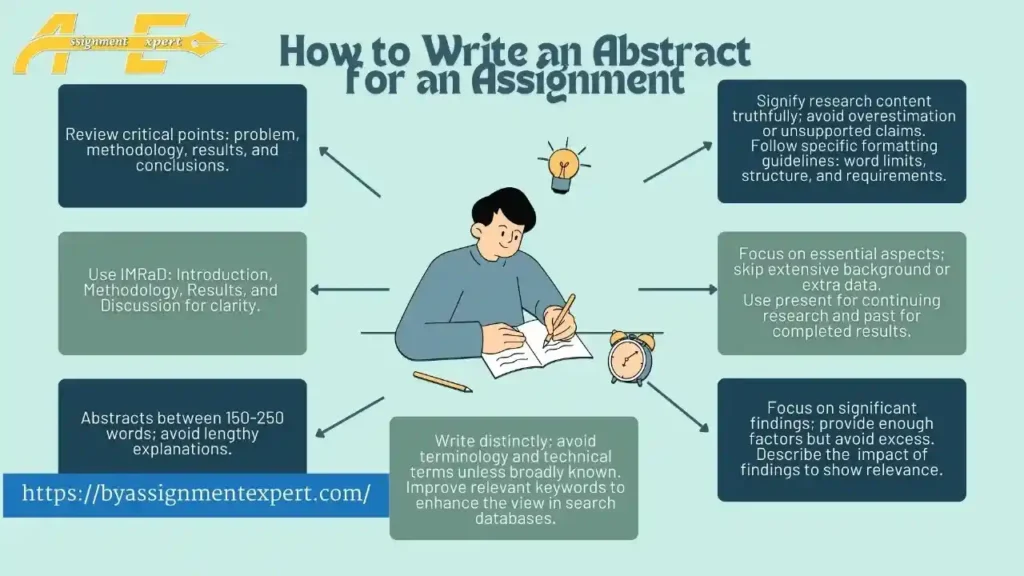An abstract is a concise summary of the entire paper, project, or presentation, summarizing its main points and findings. It explains the main points: purpose, methods, results, and conclusions. Abstracts are an important tool in helping readers quickly make a judgment about the relevance and content of the document.
You’re drafting a research proposal, preparing for a conference, or writing an academic paper, a clear abstract helps readers quickly understand the main points of your work. We will outline how to write an effective abstract, how to begin, its significant elements, formatting guidelines, examples, and even tips for writing abstracts for presentations in this blog. It will assist you to get the perfect abstract for your assignment.
How Do You Start Writing an Abstract?
There are following steps, how we can start writing an abstract.
Understand the Purpose
Abstracts offer a brief summary of research or a project that would help readers perceive the core relevance quickly. This is information on the context, hypothesis, methods, results, and conclusions; it is supposed to be brief.
Identify Your Key Points
Before you start writing, outline what the main points of your assignment are, that is, what is the research question, the methods used, and the significant findings?
Follow the Guidelines
Be sure to check that your institution or publication has specific guidelines about an abstract. This will help you meet the required standards for your abstract.
Write a Draft Summary
Write a draft of your abstract by summarizing the most critical aspects of your assignment. This will provide you with an initial draft of your abstract. Further modification is possible if one remains focused on clarity and conciseness.
Revise and Edit
When the draft is ready, go back and read it for its clarity of argument and coherence; check that it correctly represents the content and importance of your work.
Read blog: What Are Creative Writing Assignments?
Types of Abstract
There are types of abstracts: descriptive and informative.
Descriptive Abstract
A descriptive abstract briefly describes the purpose, scope, and objectives of the research without giving any information on methods, results, or conclusions. It will explain the focus of your study and its purpose.
Example of a Descriptive Abstract
Title: “Advancements in Renewable Energy Technologies”
Abstract: The past decade has witnessed significant developments in renewable energy technologies. This paper tries to look at the progress that has been made regarding technologies related to solar, wind, and hydropower during this period.
It traces improvements in efficiency and cost reductions, as well as strategies for their implementation. Significant trends and new emerging technologies that can altogether change the face of the energy sector are recognized. Continuous research and innovation are consecutively needed for the goals of sustainable energy and the solution of global problems associated with energy.
Informative Abstract
An informative abstract summarizes all basic elements of the research in detail with a statement of purpose, methodology, results obtained, and conclusions drawn. In other words, an informative abstract deals with an extended scope, hence enabling a reader to learn the whole of the study.
Example of an Informative Abstract
To illustrate, here is an example of an informative abstract for writing a reflection paper assignment :
Title: “The Impact of Climate Change on Coastal Ecosystems”
Abstract: This means that climate change affects the dynamics of species occurrence in coastal ecosystems and, consequently, the dynamics of the ecosystem. This paper, it is tested how the rise in sea level and temperature increase is affecting the coastal habitats.
This research combines field surveys with remote-sensing data to determine changes in vegetation and wildlife populations over the last decade. Evidence points to a shift in species composition and a decline in biodiversity within affected areas.
The findings bring out the immediate need for adaptive management strategies to mitigate these impacts and protect vulnerable ecosystems. Further research must be done on long-term monitoring and conservation efforts with regard to the continuing effects of climate change.
Basic Contents of Your Abstract
An effective abstract typically includes five essential components:
Context: What more significant problem or question does your work answer? This introduces the context within which your study makes a meaningful contribution.
Hypothesis or Objective: State your research question, hypothesis, or objective. The thing that should be clearly expressed in this section is what you wanted to discover or prove.
Methods: Provide a summary of the methodology used in your research. This will incorporate how one conducted the study, the process of sampling applied, techniques of data collection, and analysis procedures.
Results: This is where one must present the significant findings of the research work. Emphasize key results that do not have descriptions. The section should give an overview of what has been realized.
Conclusion: State how your results may add value to the literature field and whether they do, in fact, prove your hypothesis. In this section, mention the chances for future studies.
Format of the Abstract
Abstracts typically adhere to a specific format to maintain clarity and consistency:
One Paragraph: Abstracts are primarily written in one paragraph, and this paragraph is not indented.
Block Formatting: In block formatting there are no indentations at the beginning of the paragraph.
Position: The abstract must appear immediately after the title and heading pages.
Tense: Either present or past what is suitable, depending on whether you describe ongoing research or work that has already been completed.
Read related blog: How to Write an Effective APA Abstract for a Research Paper
Abstract Assignment for a Presentation
Writing an abstract assignment for a presentation gives a similar experience to writing one for a paper; the focus is brought around to summarizing your spoken content.
Understanding Audience
First, think about the audience who will be attending your presentation. During the writing of the abstract, focus on those aspects of your topic that would seem most interesting to an audience and grab their attention.
Summarize Key Points
Put down the main points of your presentation: the introduction, key arguments, evidence used, and conclusion. Make sure the abstract includes most of the things that are going to be said in the talk.
Show the importance
Tell them why your topic is important. Show why that topic is relevant and what contributions are made in the field by presentation.
Highlight the Importance
Presentation abstracts are the shortest possible. Try making it concise enough that it gives enough information to entice interest and will give a fit overview of your talk.
Revise for Clarity
This is the abstract presentation that should be as clear as the written abstract. It should not be burdened with jargon, and the meaning should be clear to the audience.
Example of a Presentation Abstract
Title: “The importance of AI in Future Healthcare”
Abstract: Artificial intelligence has been at the forefront of healthcare, characterized by increasing diagnostic accuracy and efficiency of treatment. It covers recent advancements in AI applications in healthcare, including machine learning algorithms, predictive analytics, and precision medicine. Various case studies will be showcased to provide insight into the potential advantages of AI. The participants will benefit from the discourse on trends of the day, the way forward, and the ethical issues surrounding the application of AI in health. This presentation is meant to provoke discussions about how AI can be utilized in improving patient outcomes and healthcare delivery.
Tips for Writing a Good Abstract Assignments
- Review critical points: problem, methodology, results, and conclusions.
- Use IMRaD: Introduction, Methodology, Results, and Discussion for clarity.
- Abstracts between 150-250 words; avoid lengthy explanations.
- Write distinctly; avoid terminology and technical terms unless broadly known.
- Improve relevant keywords to enhance the view in search databases.
- Focus on significant findings; provide enough factors but avoid excess.
- Describe the impact of findings to show relevance.
- Focus on essential aspects; skip extensive background or extra data.
- Use present for continuing research and past for completed results.
- Recheck for clarity, grammar, and accuracy; ensure the abstract is error-free.
- Alter detail level to match journal or discussion audience expectations.
- Signify research content truthfully; avoid overestimation or unsupported claims.
Things to Avoid When Writing an Abstract
When crafting an abstract assignment, it’s essential to focus on clarity, conciseness, and relevance. Here are common drawbacks to avoid:
- Exclude excessive details and focus on the main points.
- Be clear; avoid excess technical terms
- Avoid too much background; state the purpose, methods, and results.
- Avoid extraneous information; state the main point of the study.
- Use the third person rather than first-person pronouns if possible.
- The prescribed structure should be followed for clarity and consistency.
- The significance and relevance of the results are explained briefly.
- Research findings must inform claims.
- Keywords to be included to make it discoverable.
- Used past tense for completed research.
- Follow specific formatting guidelines: word limits, structure, and requirements.
Final Words
The blog post contains critical guidelines concerning the writing of effective abstracts and will, therefore, always be very instrumental to anybody seeking to fine-tune their skills. You are offered clear steps, helpful tips, and common mistakes to avoid, and you get to understand what makes an abstract good.
These are critical issues of structure, conciseness, and clarity of language, among others, so that your abstract essentially becomes a good summary of your research and effectively influences the target audience. Whether it is an academic paper, a presentation, or a research report, this blog helps you with the elements you need to write abstracts that really work and support high visibility and impact.
Frequently Asked Questions About Abstract Writing
What are the significant steps to start an assignment abstract?
The initial step in writing an abstract is understanding its purpose by summarizing the core aspects of the work. The question being researched, the methods, results and conclusions are identified as the key elements. Use any guidelines given and draft a summary, making sure that it is not too long, then revise for clarity and coherence.
What is included in an abstract?
An abstract must contain five basic elements: context, background of the study, hypothesis or objective research question, methods, approach used, results, main findings, and conclusions implications of the findings. All these elements help to effectively convey the essence of the research.
What form does an abstract usually take?
Abstracts are usually written as one paragraph that is block and not indented. These should be written according to specific criteria about the length and composition that journals or institutions typically provide. This allows for uniformity and, thus, readability and accessibility of the abstract without hassle.
What is a good abstract?
The abstract should have context, hypothesis/objective, methods, results, and conclusions. The abstract should be brief, clear, and logically coherent subject to formatting requirements.
How can we avoid common mistakes when writing an abstract for an assignment?
These include too much detail, jargon, excess background information, the addition of irrelevant content, and making unsupported claims. Your abstract should be clear and concise while it represents your research accurately, following the proper format and guidelines.
















